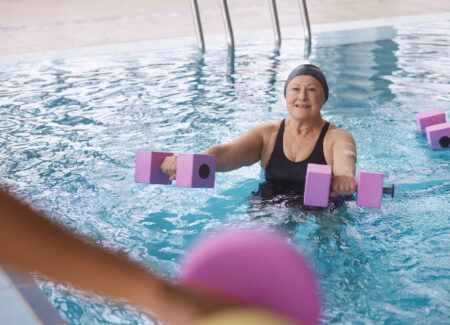
Aquatic therapy, or water therapy, is a form of exercise that is performed in temperature-controlled pools but you may wonder what is aquatic therapy used for. Water-based physical therapy offers a safe, supportive environment that is gentle on the body while still allowing participants to build strength and endurance with therapeutic exercise. Aquatic therapy can be fun and effective for nearly everyone—but it is highly-beneficial for individuals with specific symptoms, injuries, and conditions. In this post, we will look at aquatic therapy benefits for several many common health conditions.
If your physical therapist recommends aquatic therapy, there is a good reason—or several good reasons. Water physical therapy differs from traditional, land-based exercise in a few key ways:
Buoyancy
Buoyancy is an upward force exerted by water that allows the body to float. The gravity-free environment of the swimming pool removes the risk of falling, reduces the impact on weight-bearing joints by half, and allows for smoother, less painful movement.
Hydrostatic Pressure
Water exerts hydrostatic pressure on the body when submerged. Increased hydrostatic pressure increases circulation, reduces swelling, and helps with breathing both in and out of the pool. These benefits are important for patients recovering from injury or surgery, as hydrostatic pressure improves oxygen supply to muscles to speed healing.
Resistance
Resistance is a vital part of any exercise program where increased strength, flexibility, and endurance are the goals. It takes more force to move the body against water than in the air, making it an ideal environment to improve strength while not compressing the joints.
You don’t have to be injured or symptomatic to enjoy the benefits of water exercise. It is a safe, fun activity that’s available to everyone. But if you are living with chronic pain, stiffness, or mobility issues, you can participate too.
Here are some health conditions that may benefit from aquatic physical therapy.
Sprains and Strains
A strain occurs when the muscles that connect bones to muscles. Sprains are tears or overstretching of the ligaments that connect the bones. These injuries typically happen from falls, overexertion, and repetitive motions.
Water-based physical therapy promotes healing of damaged tissue and allows the patient to regain strength and mobility in the affected area with reducing the risk of reinjury.
Arthritis
Arthritis affects nearly 60 million adults in the U.S. Of all arthritis symptoms, pain is the top complaint. And unfortunately, that causes many people with arthritis to become inactive. But exercise is one of the best ways to manage symptoms and maintain mobility and function. Water-based exercise supports painful joints and provides safe resistance to build or maintain muscle and reduce swelling.
Back and Knee Pain
The buoyancy that water provides reduces stress on the spine. That is good for anyone with back pain striving to stay active and rebuild strength. Twisting and turning is easier in the water, making it possible for patients to do some exercises in the pool that they cannot do out of the water.
The same properties that make water therapy ideal for back pain are also true for knee pain. In the water, stretching and strengthening of the knee structures is safer and smoother—that is good news for weak or damaged knee joints.
Bursitis
Bursitis is inflammation of the tiny, fluid-filled sacs that cushion the muscles, tendons, and bones near the joints. Bursitis pain, stiffness, and swelling typically occurs in the hips, elbows, and shoulders. Aquatic exercise therapy to strengthen muscles in the affected areas can lessen bursitis pain and prevent future flare-ups.
Ankle Pain
It is difficult to rehabilitate from an ankle injury in a way that decreases the load on this weight-bearing joint. Patients who have ankle pain from a recent injury or conditions that cause ankle pain and inflammation without injury can remain active and fit with water therapy. Aquatic therapy also helps patients with ankle instability to improve balance and possibly prevent falls.
Fibromyalgia
Four million adults in this country live with widespread pain and fatigue due to fibromyalgia. Aquatic therapy helps patients with fibromyalgia enjoy decreased pain and stiffness and better range of motion through gentle, water-based exercise. Research also shows that sleep quality is notably improved for patients with fibromyalgia who participate in water physical therapy compared to those who do land-based physical therapy alone.
Neurologic Conditions
Patients with certain neurological disorders may have uncontrollable tremors and problems with balance and coordination. That makes land-based exercise more hazardous. In the water, the risk of falls and fall injuries is removed, allowing patients to move and exercise with confidence. Warm water also acts to reduce the stiffness and rigidity that are common among people living with Parkinson’s.
The list of conditions we’ve provided above is by no means complete. Aquatic therapy can be used in conjunction with other therapies for a wide variety of health symptoms and conditions. Find a physical therapy clinic near you to schedule an assessment to determine if aquatic therapy can help you feel and move better every day.

